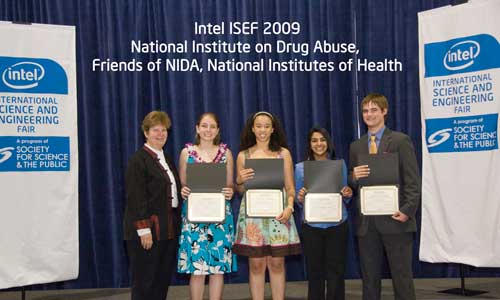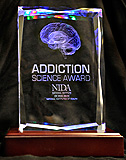 2009 Science Fair Award Winners with Dr. Lucinda Miner, Deputy Director, NIDA Office of Science Policy and Communications.
2009 Science Fair Award Winners with Dr. Lucinda Miner, Deputy Director, NIDA Office of Science Policy and Communications.A resourceful study into the effect of third hand smoke upon the risk for genetic mutations in fruit flies won the top Addiction Science Award at this year's Intel International Science and Engineering Fair (ISEF), the world's largest science competition for high school students. The Intel ISEF Addiction Science Awards were presented at an awards ceremony last night by the National Institute on Drug Abuse (NIDA), part of the National Institutes of Health, and Friends of NIDA, a group that supports NIDA's mission, and educates policy makers, health professionals and the general public about advances achieved from the investments in biomedical and behavioral research related to finding a cure for and eliminating drug dependence.
The winning project, "A Cytogenic Analysis of Genetic Mutation Induced by Cigarette Smoke in Drosophila Melanogaster," was carried out by Sehar Anjum Salman and Jada Nicole Dalley, both 16-year-old juniors at Keystone High School in San Antonio, Texas. The young scientists observed and measured the frequency of observable genetic mutations among Drosophila melanogaster (fruit flies) that were exposed as larvae to a piece of foam that had been previously saturated with tobacco smoke. They observed a surprisingly high rate of mutations, many of which point to interesting genes that could improve our understanding of the deleterious effects of environmental tobacco smoke exposure in humans. Third hand smoke is comprised of the toxic particles left behind by cigarette smoke on items like clothing, furniture and draperies. Little is known about the effects of third hand smoke on human health.
"What impressed us most about these young scientists was their ability to design and complete an extremely successful scientific project without having access to a college- level laboratory," said NIDA Director Dr. Nora D. Volkow. "They showed great imagination and creativity in using a variety of resources, including an Atlas of Drosophila melanogaster mutants, to maximize the results and potential significance of their efforts. As a result, they have made a timely contribution to an emergent and important area of research."

Winning second place distinction was Daniel Jeffrey Martin, a 17-year-old junior from Desert Vista High school in Phoenix, Arizona, for his project, "The Effect of Human Methamphetamine Usage on Carnivore Scavenging." Martin made a retrospective analysis of data from a local medical examiner's office to demonstrate that carnivorous animals do not like to scavenge the remains of humans known to have abused methamphetamine. He came up with the idea after his mother, a forensic scientist, told him there was anecdotal evidence that carnivores stayed away from bodies of people whose autopsy revealed the presence of methamphetamine.
"Daniel Martin took something that had been forensic lore, and turned it into a very interesting project that could have implications for forensic science," said Dr. Cindy Miner, deputy director of the NIDA Office of Science Policy and Communications, who contributed to the scientific evaluations of the student projects at the Intel competition. "This is exactly the kind of curiosity we like to see in young scientists." Dr. Ruben Baler, health science administrator at NIDA, and Dr. Steven C. Hayes, a NIDA grantee and psychology professor at the University of Nevada, also assisted with student project evaluations at the Intel fair this year.
The third place Addiction Science Award was given to a computer science project, "Complex Evaluation of Danger and Tranquility in Urban Settings: An Immunocomputing Intelligence Approach," developed by 18-year-old Lucia Mocz, a senior at Mililani High School in Mililani, Hawaii. Using an artificial intelligence algorithm, Mocz was able to generate highly detailed maps that integrate correlated indicators of danger and tranquility in the urban region of her home town.
"Although this brilliant young woman developed a tool with many universal applications, our judges recognized a provocative strategy that could one day help us better understand how the built environment relates to patterns of drug abuse," said Dr. Volkow. "This approach nicely mirrors the multidimensionality of the many factors known to influence the risk and consequences of drug abuse in our communities."
The non-profit organization, Friends of NIDA, partnered with NIDA to sponsor the award as part of its ongoing support of NIDA research into the causes, consequences, and treatment of drug abuse and addiction. "We are thrilled to be a part of this incredible scientific competition, "said Dr. William Dewey, professor and interim chairman, Virginia Commonwealth University and founder and president of the Friends of NIDA. "We are hoping this year's winners will seriously consider a career in the growing field of addiction science, and become an active part of the solution to the societal and individual devastation of drug abuse and addiction."
This year, more than 1,500 students from more than 50 countries participated in the ISEF competition at the Reno Sparks Convention Center, which is coordinated by the Society for Science and the Public. Winners of the Addiction Science Award received cash awards provided by Friends of NIDA in a ceremony Thursday night, with a $2,500 scholarship for the first-place honoree.
The nonprofit organization Society for Science and the Public partners with Intel - along with dozens of other corporate, academic, government and science-focused sponsors - to provide support and awards for the Intel ISEF each year. NIDA has developed a special section on its Web site, which includes other resources on addiction science, to help science fair entrants understand the criteria for the awards: https://www.drugabuse.gov/news-events/public-education-projects/nida-science-fair-award-addiction-science.
The Friends of the National Institute on Drug Abuse is a coalition of individuals, scientific and professional societies, patient groups and other organizations committed to the elimination of drug abuse and addiction through education, advocacy, and the promotion of broad public and private support for the research agenda of the National Institute on Drug Abuse. For more information, visit: http://www.thefriendsofnida.org.
